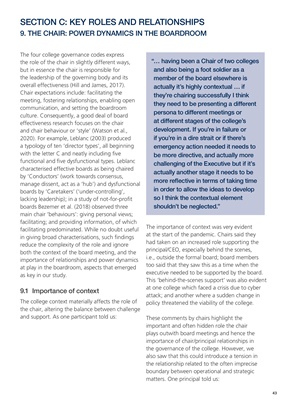
43
The four college governance codes express
the role of the chair in slightly different ways,
but in essence the chair is responsible for
the leadership of the governing body and its
overall effectiveness (Hill and James, 2017).
Chair expectations include: facilitating the
meeting, fostering relationships, enabling open
communication, and setting the boardroom
culture. Consequently, a good deal of board
effectiveness research focuses on the chair
and chair behaviour or 'style' (Watson et al.,
2020). For example, Leblanc (2003) produced
a typology of ten 'director types', all beginning
with the letter C and neatly including five
functional and five dysfunctional types. Leblanc
characterised effective boards as being chaired
by 'Conductors' (work towards consensus,
manage dissent, act as a 'hub') and dysfunctional
boards by 'Caretakers' ('under-controlling',
lacking leadership); in a study of not-for-profit
boards Bezemer et al. (2018) observed three
main chair 'behaviours': giving personal views;
facilitating; and providing information, of which
facilitating predominated. While no doubt useful
in giving broad characterisations, such findings
reduce the complexity of the role and ignore
both the context of the board meeting, and the
importance of relationships and power dynamics
at play in the boardroom, aspects that emerged
as key in our study.
9.1��Importance�of�context
The college context materially affects the role of
the chair, altering the balance between challenge
and support. As one participant told us:
The importance of context was very evident
at the start of the pandemic. Chairs said they
had taken on an increased role supporting the
principal/CEO, especially behind the scenes,
i.e., outside the formal board; board members
too said that they saw this as a time when the
executive needed to be supported by the board.
This 'behind-the-scenes support' was also evident
at one college which faced a crisis due to cyber
attack; and another where a sudden change in
policy threatened the viability of the college.
These comments by chairs highlight the
important and often hidden role the chair
plays outwith board meetings and hence the
importance of chair/principal relationships in
the governance of the college. However, we
also saw that this could introduce a tension in
the relationship related to the often imprecise
boundary between operational and strategic
matters. One principal told us:
SECTION C: KEY ROLES AND RELATIONSHIPS
9.�THE�CHAIR:�POWER�DYNAMICS�IN�THE�BOARDROOM
" … having been a Chair of two colleges
and also being a foot soldier as a
member of the board elsewhere is
actually�it's�highly�contextual�…�if�
they're�chairing�successfully�I�think�
they�need�to�be�presenting�a�different�
persona�to�different�meetings�or�
at�different�stages�of�the�college's�
development.�If�you're�in�failure�or�
if�you're�in�a�dire�strait�or�if�there's�
emergency�action�needed�it�needs�to�
be�more�directive,�and�actually�more�
challenging�of�the�Executive�but�if�it's�
actually�another�stage�it�needs�to�be�
more�reflective�in�terms�of�taking�time�
in order to allow the ideas to develop
so I think the contextual element
shouldn't�be�neglected."